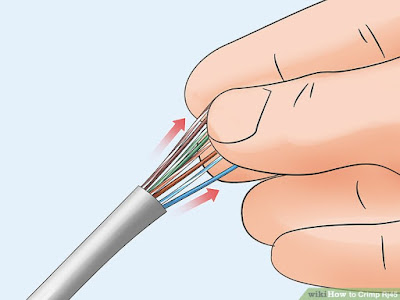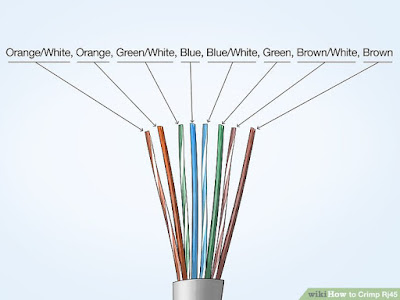WHAT ARE THE STEPS IN CRIMPING RJ-45 CONNECTOR?
The crimping process will deform the strands of the wire so that there is a gas-tight joint. Not only will this provide the greatest surface area for electrical contact, but it also prevents oxygen or moisture from reaching the metal of the wire and terminal, reducing the possibility of corrosion.
1. Cut into
the outer sheath of the cable with a pair of scissors. Take
a pair of scissors and gently cut into the plastic sheath about 1 inch
(25 mm) from the end of the cable. Make sure you don’t cut into the wires
inside. When the scissors penetrate the sheath, rotate the cable and scissors
to create a cut around the cable. Then, stick your fingertips under the sheath
and pull it off towards the end.
Tip: If you don’t have scissors, you can
use a utility knife to cut away the outer sheath. But be careful not to cut the
wires inside.
2. Separate and straighten out the small
wires in the cable. Use your fingers to
untwist and straighten the exposed wires after you remove the sheath. If there
is a plastic core or wire separator, cut it away with your scissors.
3. Put the wires in the right order. Arrange the wires from left to right so the order
is orange/white, orange, green/white, blue, blue/white, green, brown/white,
brown. They need to be arranged in a specific order to be properly crimped to
the RJ-45 connector.
4. Trim the
wires 1⁄2 inch (13 mm) away from the
sheath. Bring the wires together and hold them with your thumb and
index finger. Then, use your scissors to cut them. Make sure they’re cut evenly.
·
The
wires need to be even in order to fit into the grooves in the connector.
·
If
you cut the wires unevenly, move further down and cut them again so their ends
are in a straight line.
5. Fit the wires into the grooves of the RJ-45 connector. Hold the connector so the metal pins or brackets
are facing up and the clip is facing down. Hold the small wires together in the
right order and slide them into the connector. They should fit into the grooves
of the connector, with the end of the sheath of the cable fitting just past the
base of the connector.
6. Press the pins down with a flathead screwdriver. Locate the small metal pins at the ends of the
grooves of the connector. Use a thin, flathead screwdriver to push each of the
pins down. Push the pins 1 by 1 so they’re pressed all the way into each wire.
·
Be careful not to crack or break the plastic
connector.
7. Tug on the
end of the connector to make sure it’s secure. Double
check that all of the pins are pressed into the wire, and give a light tug on
the connector to make sure it won’t slide off. Each of the pins should be
inserted at the same level to form an even line.
·
Lightly shake the cable and listen for any rattling
that could indicate that one of the pins isn’t secure.









Comments
Post a Comment